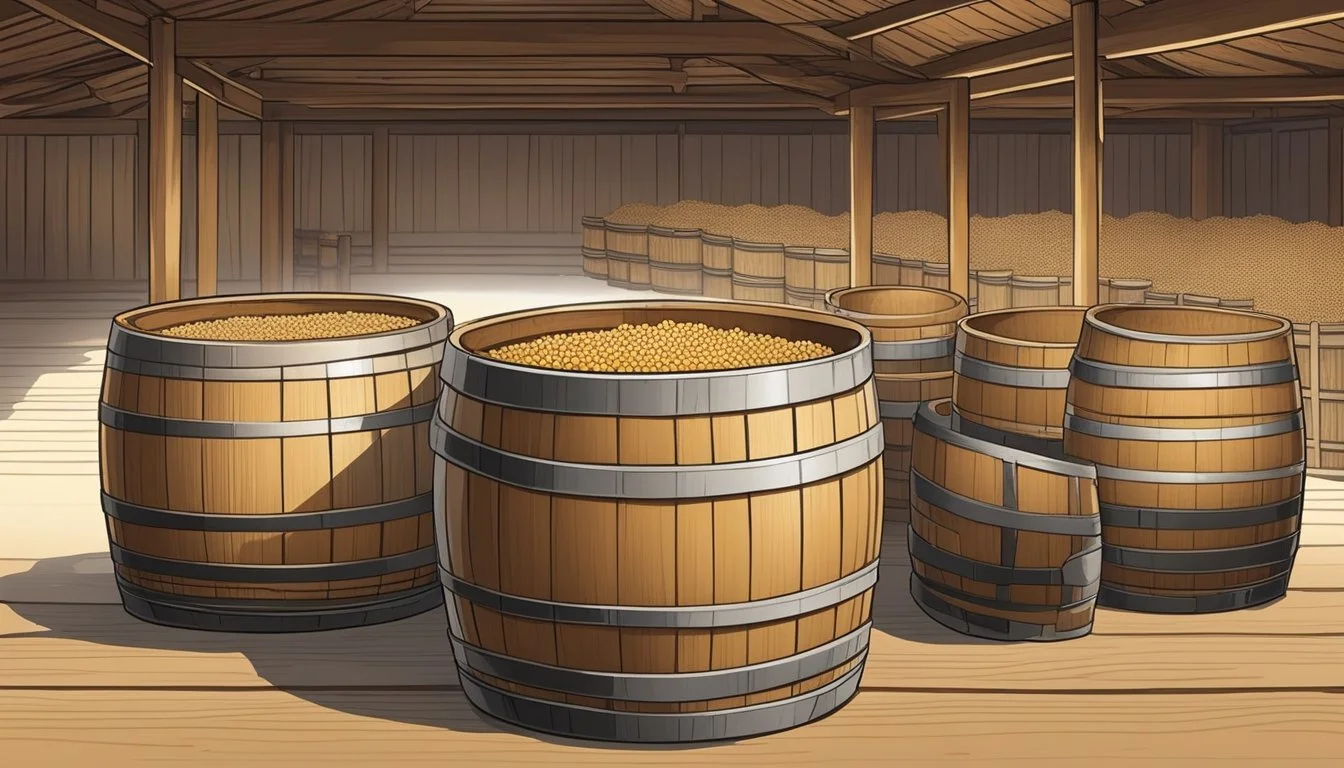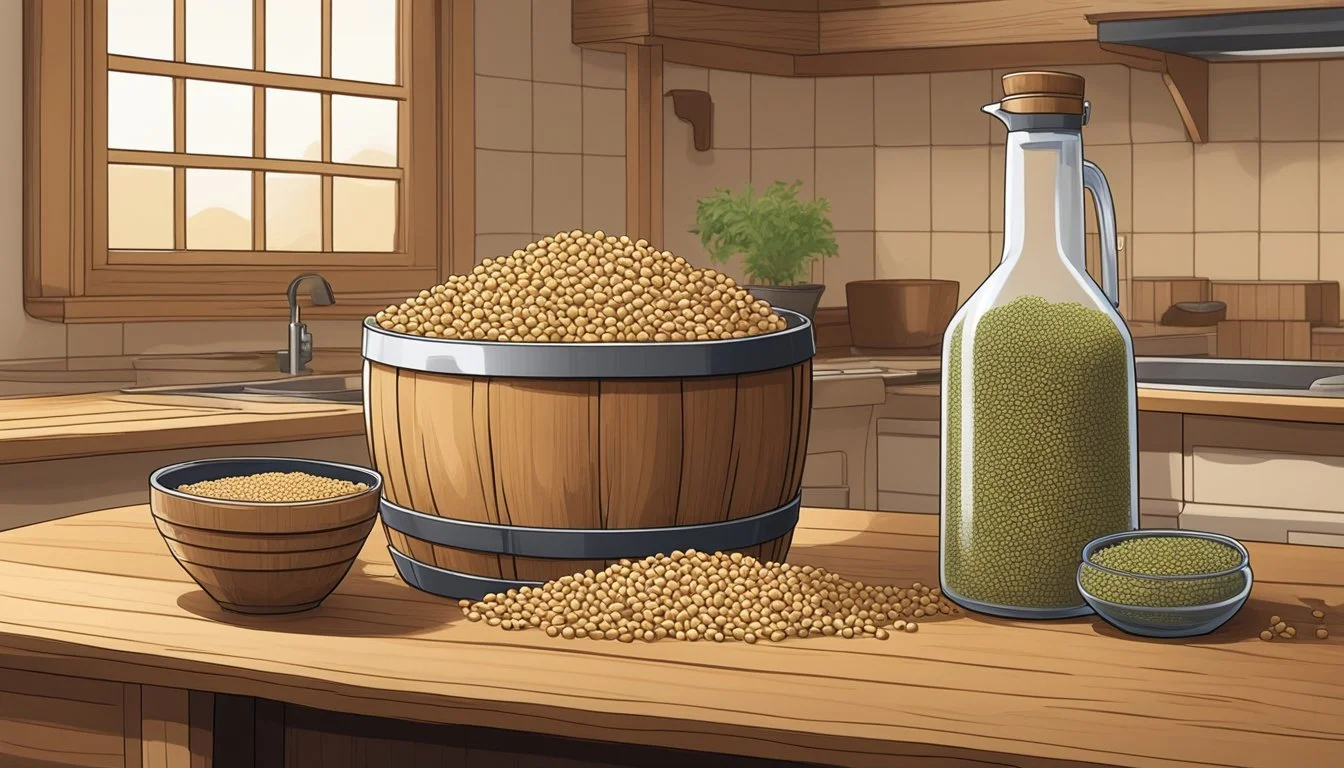How to Ferment Shoyu
Mastering Japanese Soy Sauce Fermentation
Shoyu, or Japanese soy sauce, is a cornerstone of Japanese cuisine, known for its rich umami flavor. It is made through a meticulous fermentation process, which has been perfected over centuries. The basic ingredients of shoyu are soybeans, wheat, salt, and a fermenting agent called koji. Each ingredient plays a vital role in the development of shoyu's unique taste and aroma. This process begins with the preparation of the ingredients, where soybeans are soaked, cooked, and mixed with roasted wheat.
The blend of cooked soybeans and wheat forms the substrate for fermentation. To this mixture, koji—an important fungus in Japanese food (What wine goes well with Japanese food?) science for its enzymatic properties—is added. The koji acts upon the soybean and wheat mixture, breaking down the proteins and starches into amino acids and sugars, respectively. This part of the process is critical for developing the deep and complex flavor profile characteristic of shoyu.
In the subsequent stages of fermentation, the shoyu mash, known as moromi, undergoes a transformation that can take several months to years. Throughout this period, careful monitoring is required to ensure that the culture develops appropriately. The efforts result in a raw soy sauce, which is then refined through pressing and clarifying. Pasteurization will follow to ensure the sauce's longevity and consistency in its flavor, color, and aroma. Producing shoyu at home can be a rewarding endeavor, offering insight into the traditional culinary arts of Japan.
History and Cultural Significance
The story of shoyu begins centuries ago, emerging as a cornerstone in Japanese cuisine and eventually capturing the palates of global diners.
Origins of Shoyu
Shoyu, or Japanese soy sauce, sprang from a fermentation process that likely originated in China and found its way to Japan around the 7th century. The Japanese refined the technique into an artisanal craft, producing a condiment that's both a staple and a delicacy. The oldest type of Japanese soy sauce, tamari, was first created as a by-product of miso (fermented soybean paste) making.
Shoyu in Japanese Cuisine
Within Japanese cuisine, shoyu is a foundational flavor. Its use extends across a broad spectrum of dishes – from enhancing a simple bowl of rice to serving as a key ingredient in complex marinades and dipping sauces. The standard type of soy sauce typically used is koikuchi, which offers a balance of sweetness, saltiness, and umami that complements and elevates the inherent flavors of the food.
Global Influence
Shoyu's rise to culinary prominence did not stop in Japan. Its versatile flavor and utility have led to widespread adoption in kitchens around the world. The soy sauce variety saishikomi shoyu, recognized for its rich texture and robust flavor, exemplifies shoyu's haute cuisine status in international markets. As a result, shoyu transcends cultural boundaries and is celebrated in countless dishes globally.
Understanding the Ingredients
The production of shoyu hinges on the quality and balance of its four central ingredients: soybeans, wheat, salt, and water. Each ingredient has a distinct role and contributes to the unique flavor profile and umami characteristic of shoyu.
Soybeans and Their Role
Soybeans stand at the heart of shoyu, providing the essential proteins that break down during fermentation to create umami and complex flavors. Typically, soybeans are steamed to begin the fermentation process, which significantly affects the final taste.
Wheat's Contribution to Flavor
Wheat is equally crucial, contributing to the nuanced flavor and the sweetness in shoyu. It is often roasted and crushed before combining with soybeans, impacting the shoyu's aroma and deep flavor.
The Importance of Salt and Water
The mixture of salt and water creates a brine, which acts as a preservative and flavor enhancer. It helps regulate the fermentation process, ensuring that beneficial microbes thrive while inhibiting the growth of unwanted bacteria. The quality of the water used is critical, as it affects the overall taste and texture of the soy sauce.
The Fermentation Process
The Shoyu fermentation process is a carefully orchestrated series of stages, where the magic of umami-rich soy sauce unfolds. This section explores the intricate steps from Koji cultivation to the aging of the sauce.
Koji Cultivation
The foundation of Shoyu fermentation begins with Koji, which is steamed soybeans inoculated with Aspergillus oryzae mold. This mold is crucial as it breaks down the proteins and starches in soybeans into amino acids and sugars, setting the stage for fermentation. Koji is cultivated under specific conditions of humidity and temperature, usually around 30°C, for about 48 hours. During this time, mold spores germinate, producing enzymes responsible for the transformation of ingredients in later phases.
Moromi: The Fermentation Mash
Once Koji cultivation is complete, it is combined with saltwater brine to create Moromi, the primary fermentation mash. This mixture is rich in enzymes from the Koji and bacteria that kickstart the fermentation process. Grains such as roasted wheat may be added, which contribute to the final flavor. This mash is left to ferment for several months, during which the enzymes continue to break down proteins and carbohydrates. Stirring the Moromi regularly ensures even fermentation and prevents unwanted bacteria from spoiling the mixture.
Ingredients: Koji, saltwater brine, (optional) roasted wheat
Environment: Controlled, to prevent spoilage
Duration: Months-long process, stirring regularly
Aging and Maturation
The last stage is the aging process, where the Moromi is left to mature further, which can range from several months to years. As the sauce ages, it develops complexity, depth, and the characteristic flavor of Shoyu. The aged mixture is then pressed to extract the liquid Shoyu, leaving behind solids. The raw soy sauce is clarified to remove any sediments and oil, and finally, it is pasteurized to kill any harmful bacteria, stabilize the flavor, and extend shelf life.
Result: Mature, complex flavor profile
Procedure: Pressing, clarifying, pasteurizing
Purpose: Stabilization, flavor enhancement, and safety
Varieties of Shoyu
Shoyu, otherwise known as Japanese soy sauce, is characterized by different varieties, each with its unique qualities and purposes. They range from dark, all-purpose types to lighter, sweeter alternatives, as well as gluten-free options.
Koikuchi: The All-Purpose Standard
Koikuchi shoyu is the predominant type of soy sauce in Japan, making up about 80% of the domestic soy sauce market. It is a dark soy sauce, richer and more full-flavored than other varieties. Known for its versatility, koikuchi is used in a wide array of Japanese dishes from marinades to dipping sauces.
Usukuchi: The Lighter Alternative
Usukuchi, or light soy sauce, is saltier and has a lighter color than koikuchi. It is commonly used in the Kansai region of Japan. Despite its lighter hue, usukuchi is more concentrated, which allows it to season dishes without darkening their appearance, making it ideal for soups (What wine goes well with soups?), broths, and delicate cuisine.
Tamari: A Wheat-Free Option
Tamari is a type of shoyu that is traditionally made without wheat, which often makes it gluten-free. Tamari is generally thicker and darker than koikuchi and has a robust umami flavor. Since it has little to no wheat content, tamari is also a popular soy sauce alternative for those with gluten sensitivities.
Specialty Shoyus
Specialty shoyus include a variety of unique soy sauces with different flavor profiles and uses. Among them are shiro shoyu, which is particularly light in color and taste, allowing it to enhance dishes without changing their color significantly. These specialty sauces often require more elaborate production processes and can vary widely in flavor, color, and texture.
Culinary Uses
Shoyu, with its rich umami flavor, serves as a versatile foundation in Japanese cuisine. It's a valuable seasoning that enhances a spectrum of dishes, pervading them with its distinctive salty yet subtly sweet depth.
Classic Dishes and Condiments
Shoyu is integral to the preparation of sushi, where it acts as a dipping sauce, complementing the fish's freshness. In condiments like ponzu, a citrus-based sauce, shoyu is blended to balance the tang with its savory notes. It also pairs well with wasabi, providing a flavorful base for this potent condiment.
Marinades and Seasoning
When it comes to marinating proteins such as fish or chicken, shoyu is a natural choice. It tenderizes and imparts flavors deeply into the food. Many chefs rely on shoyu to bring life to teriyaki sauce which, when glazed over meats, offers a glossy, flavorful coating. Vegetables and tofu in stir-fries may also be seasoned with shoyu, boosting their taste profile.
Soups and Broths
In broths, shoyu is essential. It delicately seasons and colors clear soups and ramen broths without overwhelming the palate. As a component in miso soup, shoyu adds complexity and layers the flavors, enhancing the soup's overall savoriness.
Salad Dressings and Dipping Sauces
Shoyu-based salad dressings present an umami alternative to traditional western vinaigrettes. It can be combined with ingredients like rice vinegar and sesame oil to create diverse flavors for salads. As a dipping sauce, shoyu stands out, whether used plainly or mixed with elements like mirin and ginger, turning it into a multifaceted accompaniment for an array of appetizers.
Making Shoyu at Home
While making shoyu at home is a lengthy process, with the right ingredients and environment management, one can craft a rich, traditionally flavored soy sauce.
Preparing the Ingredients
The initial step in crafting homemade shoyu is gathering high-quality ingredients. The maker will need:
Soybeans: Mature, organic tan varieties are ideal.
Wheat berries: Ground to mix with soybeans.
Koji starter: To inoculate the mixture and begin fermentation.
Process:
Soak the soybeans overnight.
Boil until tender, ensuring they retain structure and don't fall apart.
Mix the cooked, drained soybeans with the ground wheat berries.
Allow cooling before sprinkling over and thoroughly mixing in the koji starter.
Managing the Fermentation Environment
Controlling the environment is crucial during shoyu fermentation.
Temperature and Humidity:
Maintain a consistent temperature around 30°C (86°F).
Opt for a humid environment to facilitate the growth of the koji mold.
Duration:
Fermentation typically takes months, during which the maker must monitor the mixture regularly to prevent spoilage and ensure proper mold growth.
Pressing and Bottling
After the fermentation completes, the mixture becomes a mash known as 'moromi'.
Pressing:
Place the moromi between layers of fabric to extract the liquid, which is the raw soy sauce.
Filter to remove any sediments and clarify the sauce.
Pasteurization:
Heat treat the raw soy sauce to kill any undesirable bacteria and to stabilize its flavor, color, and aroma.
Bottling:
After cooling, transfer the liquid into bottles.
Store in a cool, dark place to mature before use.
By following these detailed steps, one can produce a homemade shoyu that brings authentic Japanese flavor to the table.
Health and Dietary Considerations
When incorporating shoyu into a diet, individuals must consider its nutritional benefits, allergens including gluten content, and sodium and preservative levels.
Nutritional Benefits
Shoyu, or Japanese soy sauce, is known for its rich content of amino acids, which are essential for bodily functions and muscle development. Being a product of fermentation, it also contains beneficial microorganisms. However, the exact nutritional profile can vary depending on the brand and the type of shoyu.
Allergens and Gluten Content
Consumers with allergies should be aware that traditional shoyu contains wheat, which is a source of gluten. However, gluten-free soy sauce options are available, catering to those with celiac disease or gluten sensitivity. Individuals should always check labels to confirm the allergen information.
Sodium and Preservative Content
Shoyu is high in sodium, which can be a concern for those monitoring their salt intake. Some manufacturers offer reduced-sodium versions to address this. As for preservatives, many organic shoyu options are free from artificial preservatives, aligning with a more natural and organic dietary preference. Moreover, most traditional shoyu sauces are inherently vegan, making them suitable for those following a plant-based diet.
Storing and Preservation
Storing Shoyu properly ensures its quality and longevity. The key lies in understanding its shelf life and knowing when refrigeration is beneficial.
Shelf Life and Storage Conditions
Shoyu has an impressive shelf life due to its natural preservatives. The high sodium content acts as a preservative, allowing it to be safely stored at room temperature, even after opening. However, storage conditions can affect its quality:
Temperature: It should be kept in a cool, dark place to prevent degradation of flavor.
Light: Exposure to light can lead to changes in color and taste. Store in opaque or tinted bottles if possible.
Air: An airtight container is ideal to prevent oxidation.
Once pasteurized, bottled soy sauce maintains its stability outside of refrigeration due to the heat treatment it undergoes.
When to Refrigerate Shoyu
Refrigeration is not mandatory but can preserve the quality of Shoyu for longer, especially in certain conditions:
Extended Storage: If Shoyu won't be used quickly, refrigeration can retain its desired flavors and aromas over time.
Hot Climates: In warmer regions, refrigeration can help maintain its freshness and prevent spoilage.
Buying Guide
When selecting Shoyu, or Japanese soy sauce, it is important to understand the different types available, interpret labels accurately, and know where to find quality options. The choices can vary widely depending on the brewing process and ingredients used, so it's crucial to choose a product that will best match your culinary needs.
Selecting the Right Shoyu
When choosing the right Shoyu, consider the type that suits your cooking style. Koikuchi shoyu is the most common, offering a balance between umami and sweetness. Usukuchi shoyu is lighter and saltier, often used in Kansai region cooking to preserve the color of the dish. Dark soy sauce is aged longer and has a more intense flavor, while light soy sauce is more delicate. White soy sauce, or shiro shoyu, stands out for its color and is used when you don't want to alter the color of the dish.
Type: Koikuchi Shoyu
Profile: Balanced, versatile
Use: General use in most dishes
Type: Usukuchi Shoyu
Profile: Lighter, saltier
Use: Soups, broths, where color preservation is important
Type: Dark Soy Sauce
Profile: Rich, intense flavor
Use: Marinades, glazes
Type: Light Soy Sauce
Profile: Delicate, less salty
Use: Dressings, dips
Type: White Soy Sauce
Profile: Subtle, preserves color
Use: Delicate dishes, clear soups
Understanding Labels and Grades
Labels can offer a wealth of information about Shoyu. Look for terms such as "naturally brewed", which indicates a traditional fermentation process as opposed to chemical methods. Avoid products with additives or preservatives that can alter the flavor profile. Many Japanese soy sauces adhere to a standard grading system reflecting quality and flavor. While terms may vary, understanding labels will guide you toward purchasing a higher-grade product that enhances your cooking.
Label Term: Naturally Brewed
Meaning: Fermented with traditional methods, no chemical processing
Label Term: Without Additives
Meaning: No extra chemicals or ingredients that might shift the taste
Label Term: Grade
Meaning: Often indicated to show the quality level (e.g., special, first, standard)
Where to Purchase
Japanese soy sauce can be found at a variety of locations. Local grocery stores often carry a basic selection, while specialty Asian markets may offer a broader range. For a more comprehensive exploration, consider visiting an Asian supermarket. You may also shop at online retailers that offer a wider array of options. Always check the expiration date and storage recommendations to ensure freshness.
Purchasing Option: Grocery Store
Variety Expectation: Basic selection, commonly found brands
Purchasing Option: Asian Market
Variety Expectation: Wider variety, specialty types
Purchasing Option: Online Retailers
Variety Expectation: Broad selection, convenience of delivery
Beyond Shoyu: Related Ferments
In the realm of Japanese cuisine, soy sauce is a mere gateway into an intricate world of fermented products. Each of these ferments offers a distinct profile and culinary utility.
The Connection to Miso and Tamari
Miso, a staple in Japanese cooking, is a fermented soybean paste that shares a genesis with shoyu. It is produced through fermenting soybeans with salt and koji, a fungus also used in shoyu production. Miso comes in various types, ranging from white (shiro miso) to red (aka miso), each bearing unique flavors and uses. Tamari, often considered a byproduct of miso making, is a thicker, less salty sauce that is closer in its constitution to traditional shoyu. Unlike shoyu, tamari typically contains little to no wheat, making it a favorite among those with gluten intolerances.
Exploring Other Japanese Ferments
Japanese ferments extend beyond miso and tamari, encompassing a variety of sauces and pastes that enrich the nation's culinary portfolio. The term jiang refers to the Chinese predecessors of such ferments, a genre of sauces from which Japanese ferments have evolved. Each ferment, whether it be a sauce or paste, is carefully crafted with attention to detail from fermenting grains and legumes. They convey complex flavors and are essential ingredients in numerous dishes, enhancing umami and depth.
Creative Cooking with Shoyu
Shoyu, with its rich umami flavor, expands culinary boundaries far beyond traditional Japanese cuisine. Its versatile nature makes it ideal for innovative fusion dishes, enhancing homemade marinades and dressings, and enriching vegetarian and vegan dishes.
Fusion Dishes
Fusion cuisine often seeks to marry distinct culinary traditions, and shoyu offers a perfect medium for this blend. Chefs might incorporate shoyu into a classic Italian pasta to add depth or give a twist to Mexican salsa for an extra layer of flavor. The umami of shoyu complements a wide range of ingredients, making it a staple in creative fusion cooking.
Pasta: Shoyu adds a subtle richness when mixed into a tomato-based sauce.
Tacos: A splash of shoyu can enhance the meat or vegetable filling.
Homemade Marinades and Dressings
Shoyu forms the backbone of many marinades and dressings, imparting a savory taste that elevates the flavors of meats, fish, and vegetables.
Marinade:
Chicken: Shoyu and garlic create a simple yet flavorful marinade.
Fish: Shoyu and lemon infuse fish with a bright, savory note.
Salad Dressings:
Vinaigrette: Shoyu mixed with olive oil and vinegar offers a twist on a classic vinaigrette.
Creamy Dressings: Adding a teaspoon of shoyu to mayonnaise-based dressings can intensify the flavor profile.
Vegetarian and Vegan Applications
Shoyu's flavor-enhancing properties make it especially valuable in vegetarian and vegan cooking, where it can replace fish-based sauces to season dishes.
Vegetable Stir-Fry (What Wine Pairs Perfectly With Vegetable Stir-Fry?): Using shoyu as a stir-fry sauce adds complexity and richness, making vegetables more appealing.
Tofu: Marinating tofu in shoyu before baking or frying can significantly enhance its taste.
Frequently Asked Questions
In this section, readers will find insight on substitutes for traditional shoyu, how to make shoyu gluten-free, and practical cooking tips to enhance their culinary experience with shoyu.
Substitutes for Shoyu
Those unable to find traditional shoyu can consider several alternatives that offer a similar salty and umami flavor profile. Tamari, often gluten-free, closely resembles shoyu in taste but with a thicker consistency. Coconut aminos, significantly lower in sodium, provide a sweeter palate with less saltiness. Lastly, Worcestershire sauce, while more complex in flavor, can mimic some of the depth shoyu brings to dishes when in a pinch.
Making Shoyu Gluten-Free
Shoyu typically contains wheat, which poses a problem for those with gluten intolerance. To create a gluten-free variant, one must substitute the wheat with a gluten-free grain such as rice or millet. This alternative grain should be inoculated with koji in the same manner as traditional shoyu to produce the essential umami flavors.
Cooking Tips
Cooking with shoyu requires a cognizance of its intensity and depth. It's best to add shoyu at the end of the cooking process to preserve its taste and prevent it from becoming too salty. For a more nuanced flavor, shoyu can be combined with ingredients like mirin or sesame oil to create a balanced and rich seasoning suitable for various dishes.







